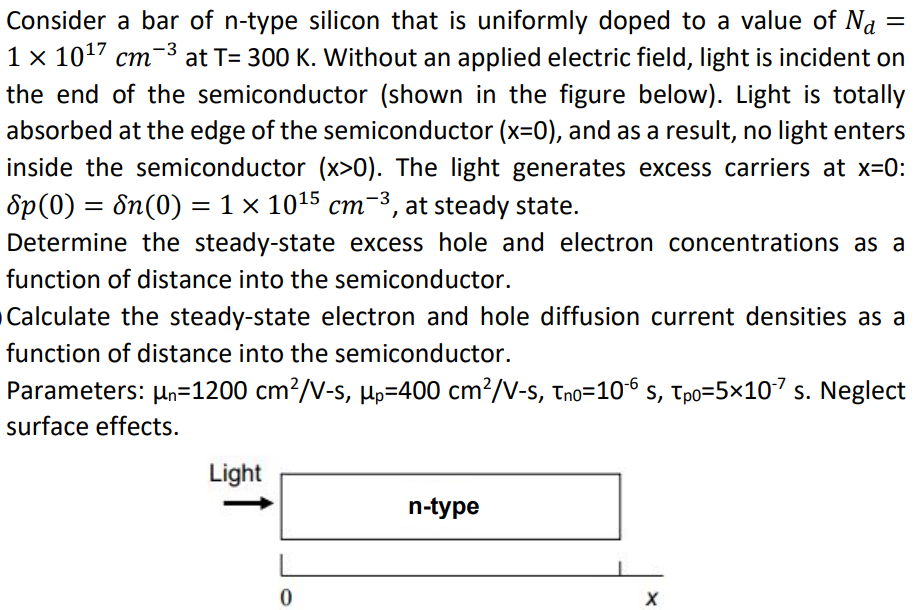Consider a bar of n-type silicon that is uniformly doped to a value of Nd 1 x 1017 cm-3 at T= 300 K. Without an applied electric field, light is incident on %| the end of the semiconductor (shown in the figure below). Light is totally absorbed at the edge of the semiconductor (x=0), and as a result, no light enters inside the semiconductor (x>0). The light generates excess carriers at x=0: Sp(0) = &n(0) = 1 × 1015 cm-3, at steady state. Determine the steady-state excess hole and electron concentrations as a function of distance into the semiconductor. Calculate the steady-state electron and hole diffusion current densities as a function of distance into the semiconductor. Parameters: Hn=1200 cm²/V-s, µp=400 cm²/V-s, tno=10-6 s, Tpo=5×107 s. Neglect surface effects.
Consider a bar of n-type silicon that is uniformly doped to a value of Nd 1 x 1017 cm-3 at T= 300 K. Without an applied electric field, light is incident on %| the end of the semiconductor (shown in the figure below). Light is totally absorbed at the edge of the semiconductor (x=0), and as a result, no light enters inside the semiconductor (x>0). The light generates excess carriers at x=0: Sp(0) = &n(0) = 1 × 1015 cm-3, at steady state. Determine the steady-state excess hole and electron concentrations as a function of distance into the semiconductor. Calculate the steady-state electron and hole diffusion current densities as a function of distance into the semiconductor. Parameters: Hn=1200 cm²/V-s, µp=400 cm²/V-s, tno=10-6 s, Tpo=5×107 s. Neglect surface effects.
Related questions
Question
please see attached...

Transcribed Image Text:Consider a bar of n-type silicon that is uniformly doped to a value of Na =
1 x 1017 cm-3 at T= 300 K. Without an applied electric field, light is incident on
the end of the semiconductor (shown in the figure below). Light is totally
absorbed at the edge of the semiconductor (x=0), and as a result, no light enters
inside the semiconductor (x>0). The light generates excess carriers at x=0:
Sp(0) = ôn(0) = 1 × 1015 cm¯3, at steady state.
Determine the steady-state excess hole and electron concentrations as a
function of distance into the semiconductor.
OCalculate the steady-state electron and hole diffusion current densities as a
function of distance into the semiconductor.
Parameters: Hn=1200 cm?/V-s, Hp=400 cm?/V-s, Tno=10° s, tpo=5×107 s. Neglect
surface effects.
Light
n-type
Expert Solution
This question has been solved!
Explore an expertly crafted, step-by-step solution for a thorough understanding of key concepts.
This is a popular solution!
Trending now
This is a popular solution!
Step by step
Solved in 3 steps
